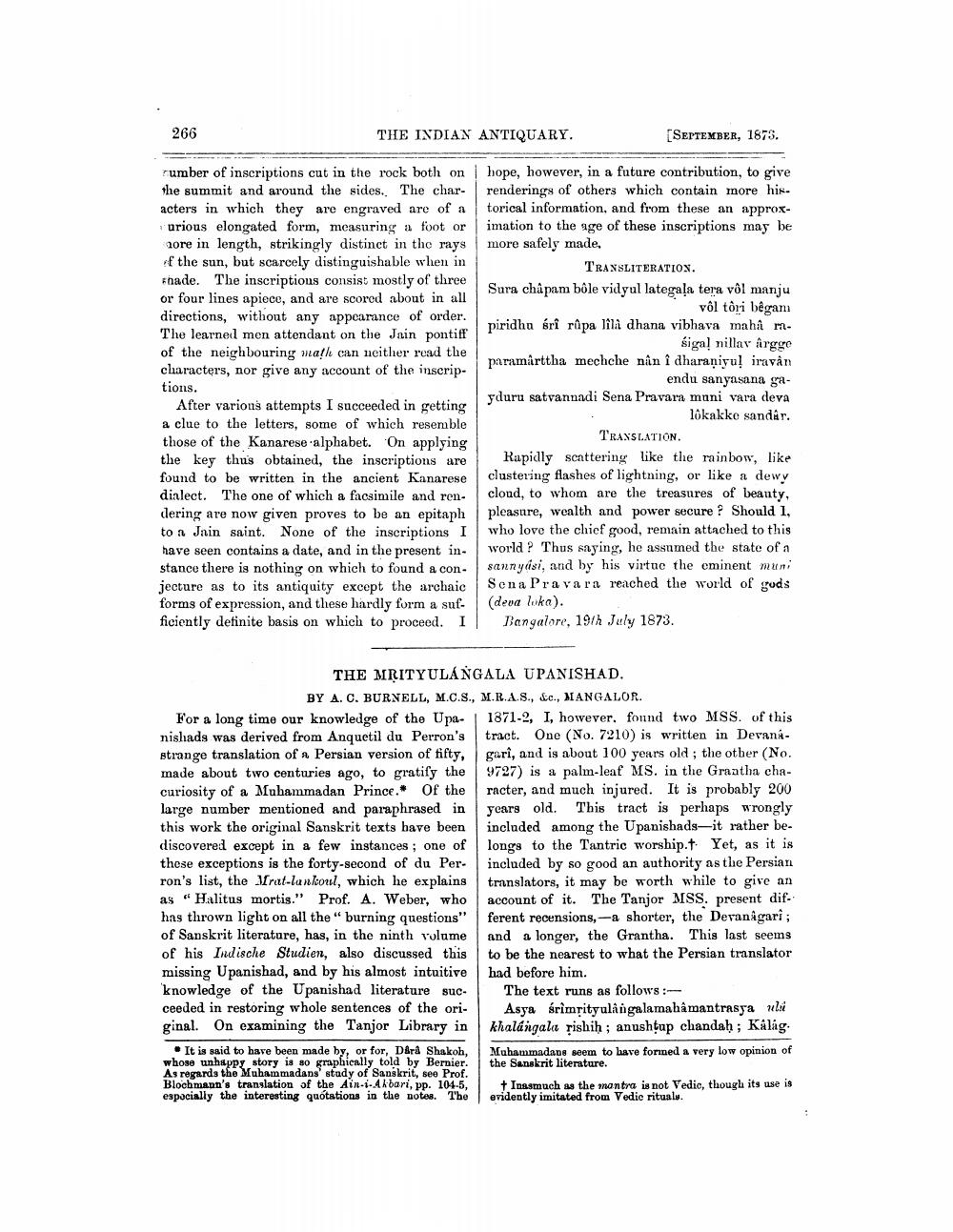________________
266
THE INDIAN ANTIQUARY.
[SEPTEMBER, 1875.
rumber of inscriptions cut in the rock both on the summit and around the sides. The char- acters in which they are engraved are of a urious elongated form, measuring a foot or aore in length, strikingly distinct in the rays of the sun, but scarcely distinguishable when in shade. The inscriptions consist mostly of three or four lines apiece, and are scored about in all directions, without any appearance of order. The learned men attendant on the Jain pontiff of the neighbouring math can neither read the characters, nor give any account of the inscriptions.
After varions attempts I succeeded in getting a clue to the letters, some of which resemble those of the Kanarese -alphabet. On applying the key thus obtained, the inscriptions are found to be written in the ancient Kanarese dialect. The one of which a facsimile and rendering are now given proves to be an epitaph to a Jain saint. None of the inscriptions I have seen contains a date, and in the present in. stance there is nothing on which to found a con. jecture as to its antiquity except the archaic forms of expression, and these hardly form a suf. ficiently definite basis on which to proceed. I
hope, however, in a future contribution, to give renderings of others which contain more his. torical information, and from these an approximation to the age of these inscriptions may be more safely made.
TRANSLITERATION. Sura chápam bôle vidyul lategala tera vôl manju
vôl tori bêgam piridha éri rûpa lili dhana vibhava mahî m.
sigal nillar ärgge paramarttha mechche nîn î dharaniyu! iravan
endu sanyasana gayduru satvannadi Sena Pravara muni vara deva
lokakke sandár. TRANSLATION. Rapidly scattering like the rainbow, like clustering flashes of lightning, or like a dewy cloud, to whom are the treasures of beauty, pleasure, wealth and power secure? Should I, who love the chief good, remain attached to this world? Thus saying, he assumed the state of a sannyisi, and by his virtue the eminent muni Sena Pra vara reached the world of gods (deva luka).
Bangalore, 19/h July 1873.
THE MRITYULÁNGALA UPANISHAD.
BY A. C. BURNELL, M.C.S., M.R.A.S., &c., MANGALOR. For a long time our knowledge of the Upa- | 1871-2, I, however, found two MSS. of this nishads was derived from Anquetil du Perron's tract. One (No. 7210) is written in Devankstrange translation of a Persian version of fifty, gari, and is about 100 years old ; the other (No. made about two centuries ago, to gratify the 9727) is a palm-leaf MS. in the Graatha chacuriosity of a Muhammadan Prince. Of the racter, and much injured. It is probably 200 large number mentioned and paraphrased in years old. This tract is perhaps wrongly this work the original Sanskrit texts have been included among the Upanishads-it rather bediscovered except in a few instances; one of longs to the Tantric worship.t. Yet, as it is these exceptions is the forty-second of du Per. included by so good an authority as the Persian ron's list, the frat-lankoul, which he explains translators, it may be worth while to give an as "Halitus mortis." Prof. A. Weber, who account of it. The Tanjor MSS. present difhas thrown light on all the burning questions" ferent recensions,-a shorter, the Devanagari ; of Sanskrit literature, has, in the ninth volume and a longer, the Grantha. This last seems of his Indische Studien, also discussed this to be the nearest to what the Persian translator missing Upanishad, and by his almost intuitive had before him. knowledge of the Upanishad literature suc- The text runs as follows:ceeded in restoring whole sentences of the ori- Asya srimsityalángalamahamantrasya uli ginal. On examining the Tanjor Library in khalangala rishih ; anushtap chandah; Kálág.
It is said to have been made by, or for, Dara Shakoh, Muhammadane seem to have forined a very low opinion of whose unhappy story is so graphically told by Bernier. the Sanskrit literature. As regards the Muhammadans' study of Sanskrit, see Prof. Blochmann's translation of the Ain-1.4kbari, pp. 104-5, Inasmuch as the mantra is not Vedio, though its use is espacially the interesting quotations in the notes. The evidently imitated from Vedic rituals.




